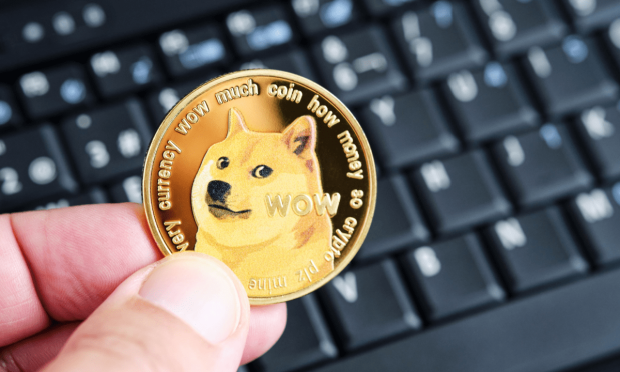What Will Dogecoin’s Future be on Twitter?

When Tesla CEO Elon Musk walked into Twitter headquarters carrying a sink last week, the price of his favorite memecoin doubled. When it was reported that he stopped development work on Twitter’s crypto digital wallet yesterday (Nov. 3), it dropped 10%.
If you pay any attention at all to crypto, you know that we’re talking about dogecoin, the Shiba Inu-fronted, built-as-a-joke memecoin.
With its value so tied up in one person’s whims and tweets who also now controls the social media platform, it could be argued that dogecoin seems like the worst possible choice as a payment currency — especially since it was actually designed in 2013 to be unusable for payments.
So why is it being taken so seriously?
And more to the point, can it actually become a serious payment token when its value is so closely controlled by one man, even if he is the world’s richest person?
— Elon Musk (@elonmusk) November 1, 2022
The DOGE evolves
When Google selected Coinbase Commerce to provide the technology that would let its Google Cloud customers pay with cryptocurrencies, it was a huge marketing win for the top U.S. crypto exchange, which could now cite it alongside Blackrock as partners.
But it wasn’t the only winner. When the mainstream business news site CNBC wrote up the story it mentioned that Coinbase Commerce “supports 10 currencies, including Bitcoin, Bitcoin Cash, Dogecoin, Ethereum and Litecoin.”
Can you spot the joker in that hand?
Bitcoin and ethereum are the two largest and best-known cryptocurrencies, and Bitcoin Cash and Litecoin are two of the oldest and best-known payments-focused altcoins.
The two largest stablecoins, USDT and USDC — both top five cryptocurrencies with a combined market cap of $111 billion — went unmentioned.
Then there’s dogecoin, which has spent most of its nearly 10-year lifespan as a deep crypto-insider token known for a small cadre of fans who kept it alive even when its development foundation died off.
Then at the beginning of 2021, Elon Musk started tweeting memes about it. A look at its price history chart shows what happened.
Growing Support
Now it is the No. 8 cryptocurrency by market capitalization, worth $16.4 billion. CNBC and Bloomberg cover it regularly (albeit not always favorably). And in April, AMC movie theater chain began accepting dogecoin directly via its mobile app for tickets, with CEO Aam Aron saying it was because of a big Twitter campaign by supporters.
Exactly as promised, the AMC mobile app for AMC’s U.S. theatres now accepts online payments using Doge Coin, Shiba Inu, and other crypto currencies — thanks to Bitpay. Also Apple Pay, Google Pay and Paypal. To do so, you first will need to update to the latest version of our app. pic.twitter.com/MMy7SIxYbl
— Adam Aron (@CEOAdam) April 15, 2022
And Coinbase Commerce is hardly the only crypto payments processor that supports it.
In May, BitPay CEO Stephen Pair told PYMNTS’ Karen Webster that DOGE “made the cut” of tokens it supports because it has “an intensely loyal and active following.”
Indeed, according to PYMNTS’ June research report, “Paying With Cryptocurrency: What Consumers And Merchants Expect From Digital Currencies” dogecoin is owned by more consumers (5.6%) than any token except bitcoin (12%) or ether (6.8%).
See also: The U.S. Crypto Consumer: Cryptocurrency Use In Online and In-Store Purchases
There are notable exceptions: Block’s Cash App, Strike and Stripe do not support dogecoin. However, the first two are bitcoin maximalist, meaning they see it as the only real, viable payments token. And Stripe, which just started crypto payments support in April, has only spooled up support for the USD Coin stablecoin.
Twitter Next
Musk has done more than tweet and talk up dogecoin. It is accepted at Tesla for merchandise — albeit not cars, it has the same environmental problem as bitcoin, although that may be changing soon.
Indeed he has made repeated comments about Twitter taking dogecoin for payments, and if that happens it would be a big boost for the cryptocurrency’s credibility.
But ultimately, it has to break out of his control. The biggest knock against bitcoin as a payment currency is its volatility. While bitcoin has a big following, neither consumers nor merchants ultimately want to hold and accept something for payments that has a history of rising or falling as fast as 10% in a day. There’s a reason that stablecoins like USDC have been gaining ground with crypto payers, with their volume doubling on BitPay this year, Pair told Webster in late August.
Indeed, the vast majority of merchants that accept crypto at the point of sale or in the shopping cart use do so via crypto debit cards or payments processors — both of which immediately sell those coins and give them dollars.
Outside of countries where the economy is crumbling, crypto payers are basically investors who hold crypto and want to use it.
That state of affairs is based on cryptocurrencies’ tendency to jump or fall fast and frequently based on unpredictable market-moving events and even rumors.
But with dogecoin, that movement is caused by the whims of one person. That’s untenable.
If dogecoin is to take advantage of the boost Musk has given it in payments, holders have to stop reacting to his tweets.
For all PYMNTS crypto coverage, subscribe to the daily Crypto Newsletter.
